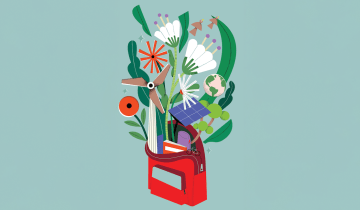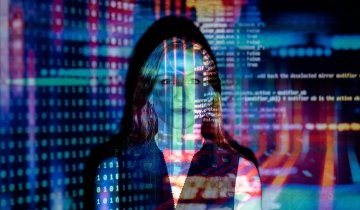It’s astonishing to reflect on the swift technological progress that has reshaped the educational landscape in just the past year. In this age of creativity and innovation, the incorporation of AI into classrooms has emerged as a vital conversation. For this interview, we’ve connected with three distinguished authorities in the field of education: Associate Professor of Education Yasemin Copur-Gencturk; Professor of Clinical Education and Engineering Anthony Maddox; and Professor of Clinical Education Corinne Hyde. They share their thoughts on how AI is influencing the future of learning, the prospects it offers and the moral dilemmas we need to confront.
Antonio Reyes: What is the role of AI in shaping the classrooms of the future?
YCG: AI will play a key role in aiding teachers and schools to meet the individual needs of students. During instruction, AI can instantly help teachers differentiate instruction based on students’ learning patterns. It can be used to tailor assignments to help students master the concepts with which they need additional help. The learning programs available for children and adults could become more interactive and personalized.
AM: With a shortage of teachers around the world, intelligent machines may be able to offer acceptable assistance. This evolution is ongoing, even as education is increasingly supported by lifelong (i.e., throughout a lifetime), life-wide (i.e., day-by-day) and life-deep (i.e., language, culture, being) learning, with classrooms only referring to physical spaces. After all, much learning takes place outside of classrooms, often prompted by what happens within classrooms.
CH: At a fundamental level, the development of AI requires us to consider the purpose of education. Do we educate so that people can remember facts and implement skills? Do we educate so that people can become productive citizens and because education gives power and freedom to the learner? When so much of what we want humans to know and be able to do can now be accomplished instantly with technology many students have in their pockets, we must critically examine what is the best use of humanity’s time, energy and resources. If used thoughtfully and with a critical eye, AI can take over simple classroom tasks—grading basic assignments, quickly providing custom materials for classroom use and engaging in conversations with students around the content. This could free teachers up for more of the things that humans do best: relationship building, social-emotional learning, innovation, differentiating to meet individual student needs and teaching lessons.
How can we ensure that educators are adequately prepared to use and integrate AI tools in their teaching methods?
YCG: As with any instructional tool we educators plan to use, we first need to investigate its affordances and limitations for helping our students. We then need to engage with the tool as if we were students to further identify the issues students might encounter while using it. This is when we can uncover how equitable the AI tool is in terms of providing learning opportunities for students from different backgrounds. It is possible that the tool might be beneficial for one group but not for another.
AM: There is significant importance of separating the skills and abilities of teachers with the role of AI. Teacher preparation may likely include the various roles that emerge between teachers and machines. It is likely that machines, at least initially, will not “understand” the roles that emotions and socialization play in teaching and learning, or may be quite limited in responding to such needs. Perhaps there is comfort in using the term “tool” to describe AI, noting it is often derogatory to call a person a “tool.” Perhaps, sooner than later, it may not be appropriate to label a machine, at least to some degree, as a tool.
“At a fundamental level, the development of AI requires us to consider the purpose of education.”
—Corinne Hyde, professor of clinical education
CH: I would question whether anyone can ever be adequately prepared to use a technology that is rapidly advancing. We can make educated guesses, but we just don’t know what AI in education will look like in the next three, five or 10 years. If we want educators to be prepared to handle AI as it is right now, then we need to provide ongoing training on the benefits and the drawbacks, as well as specific pedagogical practices that can be enhanced with AI. Educators should be engaged in communities of practice around AI use in education, and administrators need to ensure that both funding and time for professional development are in place for this to happen.
Could AI potentially replace educators in certain scenarios? If yes, where do you see this being most applicable or beneficial?
YCG: Not in the near future; however, if advances in AI are integrated with research in education, then effective, interactive learning opportunities for any subject and any population can be developed. More effective versions of MOOCs [massive open online courses] will be available for both adults and children because there will be interactive and personalized learning opportunities. AI can be used to create more effective curriculum materials and to aid teachers in differentiating instruction more effectively.
AM: The integration of machines and people has been going on for centuries. More recently, machines have demonstrated a means of reproducing human cognitive ability in a somewhat autonomous manner. My sense is that machines are unlikely to replace educators, and it may take quite a while for the effective demonstration of sharing teaching and learning responsibilities between AI and people.
CH: I don’t think AI will be able to completely replace educators (at least in the near term), because so much of education is centered around humanity—those personal connections and social interactions that support and inspire students. However, we aren’t far from the point where AI will be able to provide accurate and adaptable explanations of content. Once we reach that point, the traditional lecture could be obsolete. Students could engage with the AI outside of class time or independently during class time, and this could free up the human educator to design and facilitate learning experiences for students that involve creativity, innovation and critical thinking.
What is the most significant opportunity that AI brings to education, and why?
YCG: As an educator, the most exciting opportunity AI brings to education is the ability to create effective learning programs when content experts and AI experts can work together. This is a big “if” because I fear that the current attention being given to AI overlooks the importance of targeting specific content and delivering it effectively through AI tools. The content experts are familiar with the knowledge and skills needed to develop proficiency in a particular subject domain that should be utilized during the development of AI tools. Otherwise, AI will only perpetuate the problems already present in education. As an example, ChatGPT mainly focuses on procedural skills in mathematics, neglecting the crucial attention required for conceptual understanding, reasoning and problem-solving skills.
AM: One opportunity is its role as a force multiplier for instructors and learners at all educational levels. Currently, the manner in which people and machines distribute the “teaching and learning load” between them is unclear. Personalized education [via AI] is a brave new world that offers opportunities for everyone regardless of age, language or location; learning across space and time, so to speak.
CH: I see the most significant opportunity that AI brings to education as personalization of learning. Without AI, teachers with 20, 30 or more students simply don’t have the time to personalize learning for each student. AI could provide immediate and personalized explanations, tasks, scaffolding and more for each learner. However, as we consider this, we can’t ignore the reality that inequitably distributed resources could reinforce or even worsen opportunity gaps for students as it relates to AI. Will AI personalized learning be available to all, or only to those who can afford it?
What could be the most severe danger of integrating AI in the education sector?
YCG: Generative AI tools could be used to cheat. More importantly, many generative AI tools are designed to give answers, rather than to develop a robust understanding and other skills. Thus, these tools could hamper efforts to develop robust thinking, reasoning and problem-solving skills. The most severe danger of integrating AI is developing these tools without content experts, because AI experts are generally not experts in education.
AM: There is reason to believe that trust between people and machines is among the list of essential “understandings” needed to advance the idea that true learning is achievable. Along with trust are ideas such as autonomy and agency that will emerge as critical elements of educational interactions between people and machines. We may be wise to admit that machines will likely operate as educators and learners. New meanings will be assigned to the phrase “Trust, but verify” as a mantra for educational interactions between people and machines.
“Personalized education [via AI] is a brave new world that offers opportunities for everyone regardless of age, language or location; learning across space and time, so to speak.”
—Anthony Maddox, professor of clinical education and engineering
CH: As we begin integrating AI into education, we have to be aware that AI is not perfect and cannot relate to humans like humans can. We should never entrust the education of a human being to AI without human oversight. However, I do think that financial incentives will eventually push us in that direction. It would likely be cheaper to have students taught by AI instead of by human educators. This is a very dangerous path to take. I dread a world where students miss out on the myriad benefits of engaging with human educators and their peer learners.
As AI continues to evolve, what is one trend or development you’re most excited about in the context of education?
YCG: The opportunity to develop more personalized and accessible learning opportunities exists so that barriers around teaching and learning can be lifted. Additionally, using the interaction data to uncover the process of learning is an exciting opportunity to move the field forward.
AM: The possibility for true equity to emerge will be most exciting. Perhaps we will do away with punitive education, where being “wrong” or not following directions is met with reduced scores or embarrassment. However, equity is not one-way. We do not yet understand how well the equity between humans and machines will evolve. We certainly have not operationalized equity between humans, so there is much to be expected for all involved.
CH: I’m hoping that AI will allow us to finally break free from the current age- and grade-level-based progression that we adhere to in the U.S. We know that learners don’t all master knowledge and skills at the same pace, and we know that there can be a great deal of variation in what students know and can do at different ages. However, we still put students into age-based grade levels and then try to make the lessons work for everyone. What if, instead, we could have AI track and manage data about which student is learning which content at which time, make recommendations to educators, and then educators could determine the best learning experiences to provide for students?
How can educators balance the reliance on AI tools with maintaining the human touch in education?
YCG: We can adapt some of the strategies found in other areas where human interaction has become an issue, such as in asynchronous online learning opportunities and in playing computer games. I think that creating online discussion rooms so that educators can work together and share their experiences with AI tools might be an option.
“The most severe danger of integrating AI is developing these tools without content experts, because AI experts are generally not experts in education.”
—Yasemin Copur-Gencturk, assistant professor of education
AM: Evolving what may be termed the “machine touch” will be interesting. One perspective is that such a balance may not be under the “control” of humans or machines alone. It is hoped that AI will offer valued perspectives of what the “human touch” really is, and this is will serve as both a window and a mirror for human-machine interaction as it evolves.
CH: AI is a tool, just like a calculator, a computer or a textbook. [ES2] As long as the educator is using their own knowledge and experience to make significant educational decisions, then humanity is still in control of the educational experience. Educators also devote a significant amount of time and effort to getting to know students, building relationships, mentoring students and guiding students in their moral and social development. AI cannot currently provide that kind of support and connection to students, and the human connection is often what educators love the most about teaching. If we lose the human touch in education, it will likely not be at the hands of educators. It would be at the hands of those who want more cost-effective education at the cost of quality.
Are there any practices or strategies related to AI that you’ve adopted in your work that you believe should become a permanent part of education?
YCG: Yes, we have developed a professional development program that uses AI-based technologies to interact with and provide individualized feedback to teachers. I believe these programs could become a permanent part of teacher education, allowing teachers to receive support anytime and anywhere they need it.
AM: I’m truly focused more on the learning experiences of students, and I spend more time developing and operationalizing increased degrees of agency and autonomy in the learning spaces that have been my responsibility. I wonder what it means to exist in a space where trustworthiness is evolving, and I try to determine whether I can recognize it in myself and learners. I have yet to use any of the generative-AI platforms that have emerged, and I am striving to follow the edicts established regarding the use of AI in teaching and learning at USC. I truly believe that lifelong, life-wide and life-deep learning can result in truly personalized education. I am experimenting with decoupling time and space, to the degree that I can, from learning using the Carnegie Unit standardization, and I am developing evidence of viable ways of migrating from standardization to personalization.
CH: I think it’s too early to say if anything related to AI should become a permanent part of education. We still need to see how AI stands the test of time, and how the technology develops. The AI tools that we’re working with right now will likely look and function significantly differently in just a few years. However, I do think that using AI to quickly generate customized scaffolding tools for learners (which I do regularly) is extremely useful and likely to become standard practice in the field of education.







